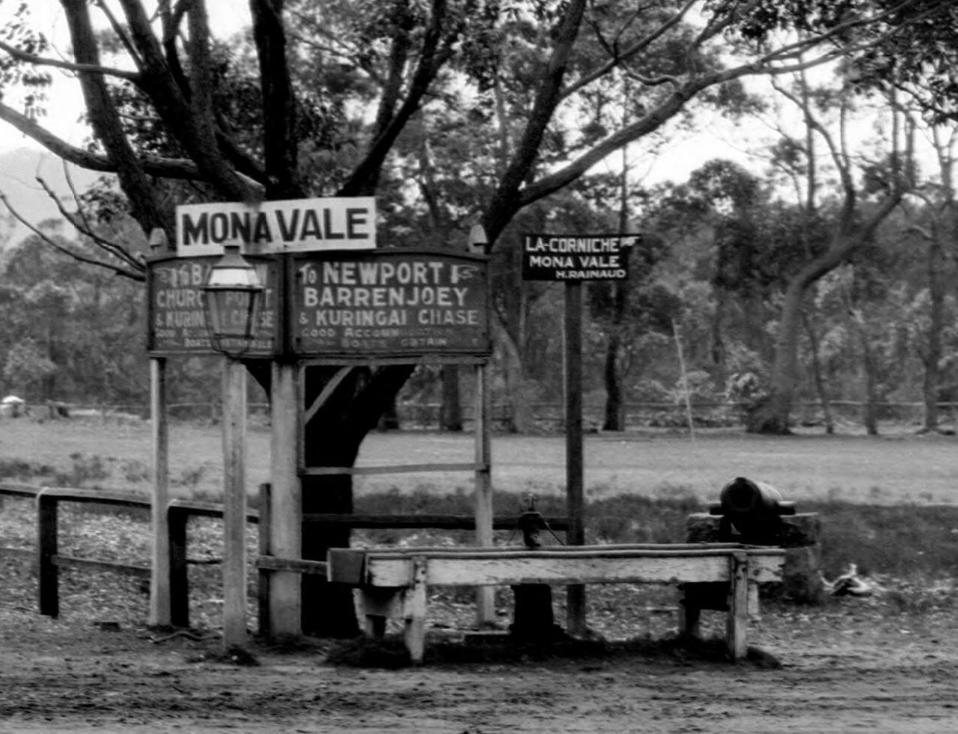Section Of A Squire Mural From Dungarvon, mona vale, held In Private Collection + a few notes about his focus on in situ aboriginal Sculptures & local burial grounds of first nations peoples
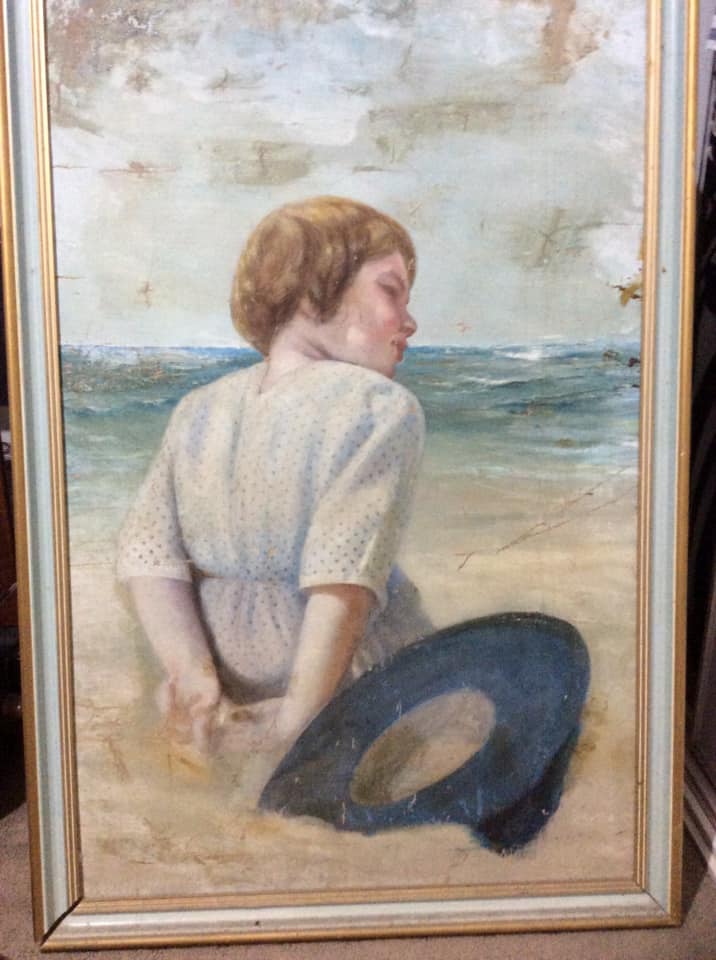
A post this week on the Facebook community forum page 'Lost Manly and the Northern Beaches', curated by Lisa Sutton Lipman, informed residents of 'Dungarvon' the Pittwater Council Heritage listed home, being placed on the market on Thursday February 8th.
'enduring heritage residence rests on an incredibly private 2033sqm of estate like grounds in the heart of Mona Vale. Sympathetically renovated in keeping with its architectural pedigree to deliver an exceptional family home, complete with a tennis court and swimming pool. A rare prospect for developers, with scope to explore the flexible zoning for home plus business opportunity or future subdivision potential (STCA).'.....• Character features with high ornate ceilings, stained glass windows, timber floors• Dining room with fireplace, separate family and lounge room• Functional kitchen with modern stainless steel appliances• Two bedrooms upstairs with walk-ins, two on the lower level• Tower lookout, timeless bathroom, laundry, ample storage• Sandstone framed in-ground pool, level lawns and tennis court'
Stone house in Federation picturesque style, with corrugated iron roof built in 1904. Eclectic blend of Queen Anne (ornamental cast iron brackets, bay windows), Federation (square tower room with window on each aspect) and Arts and Crafts (hip and gable roof and tall chimneys).Single storey dwelling with attic rooms and a central observation tower. Constructed of ashlar sandstone blocks with a rusticated finish. The façade features two symmetrically placed projecting bays. Notable for its interesting combination of roof forms and decorative external timber detailing. The dwelling is located within landscaped grounds and is well screened. (City Plan Heritage 2009).This house is historically significant as it is one of the earliest surviving houses in the locality. The lot was one of six purchased by Samuel Stringer from the Mona Vale Estate in 1902 and the first to be developed, in c.1904.
These photos were taken in 2009 of Dungarvon in Park Street, Mona Vale:
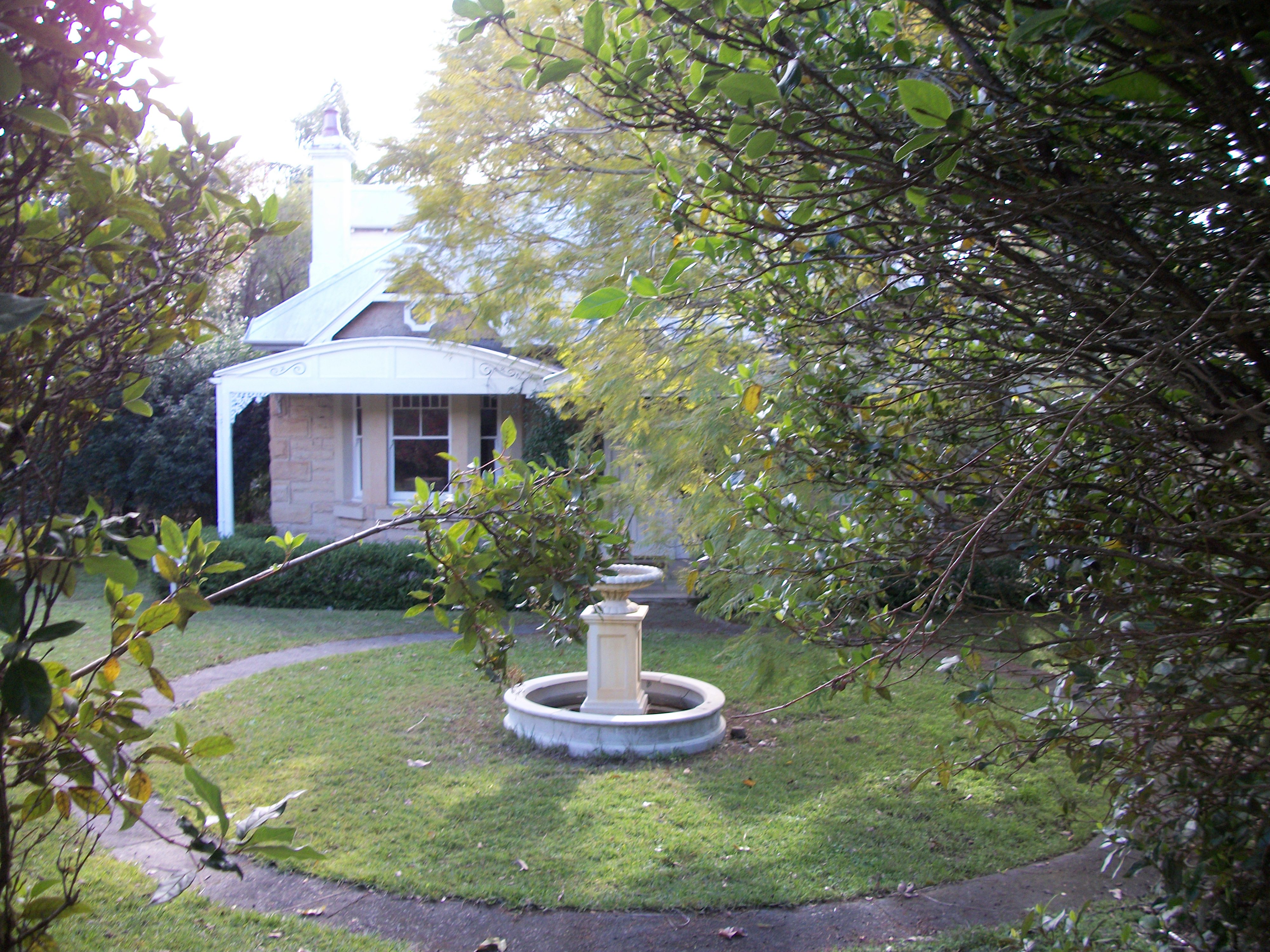
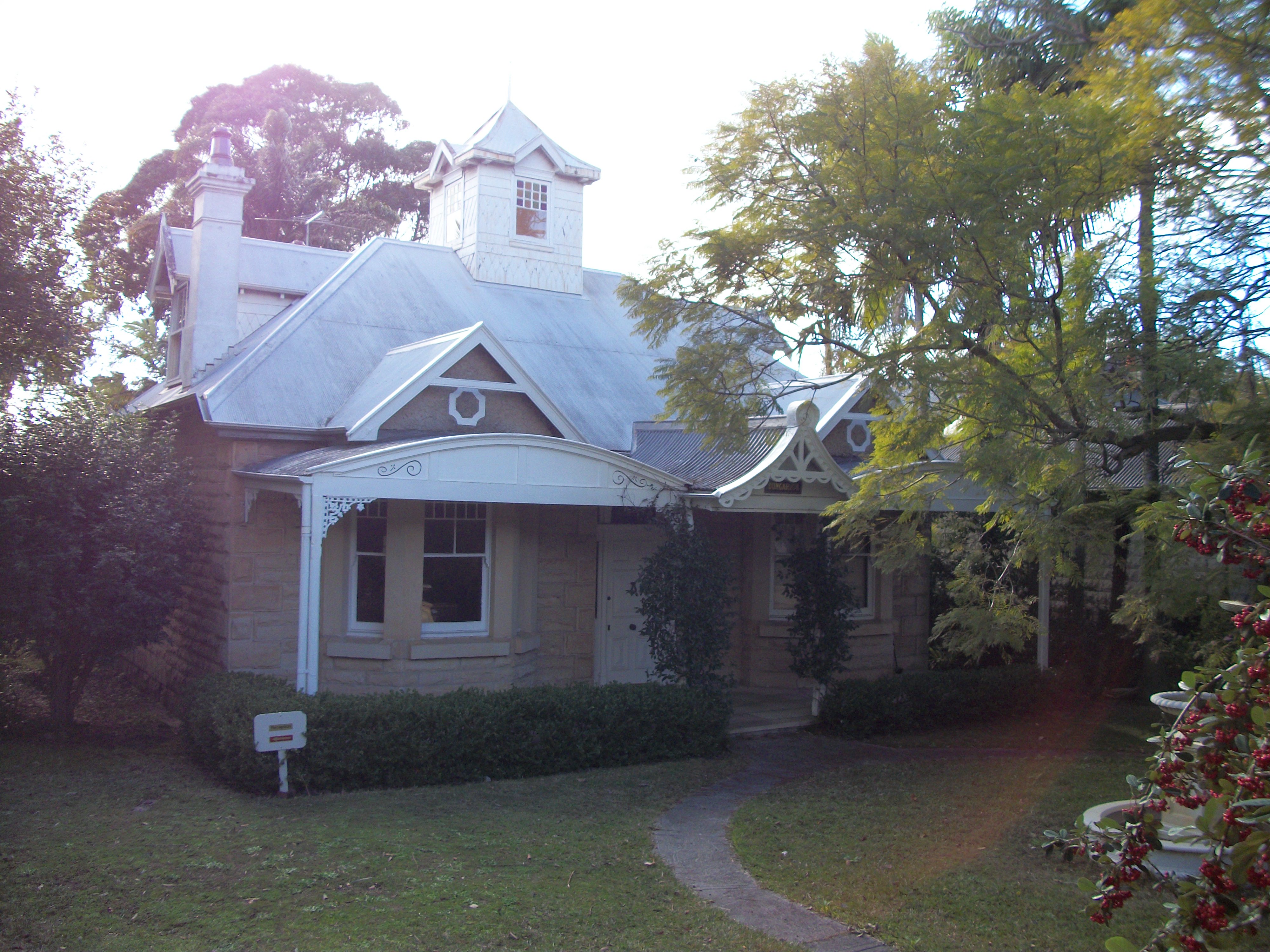
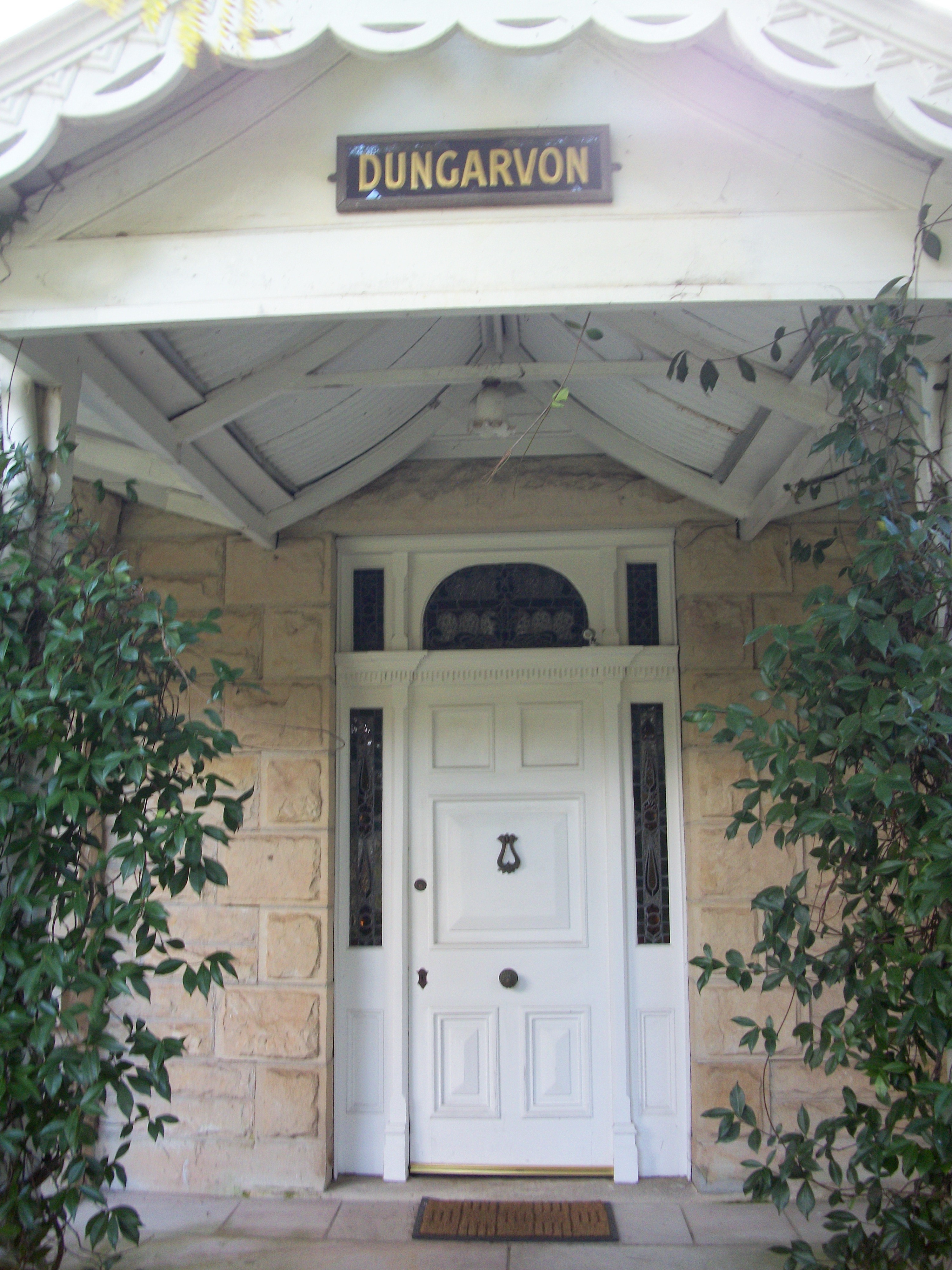
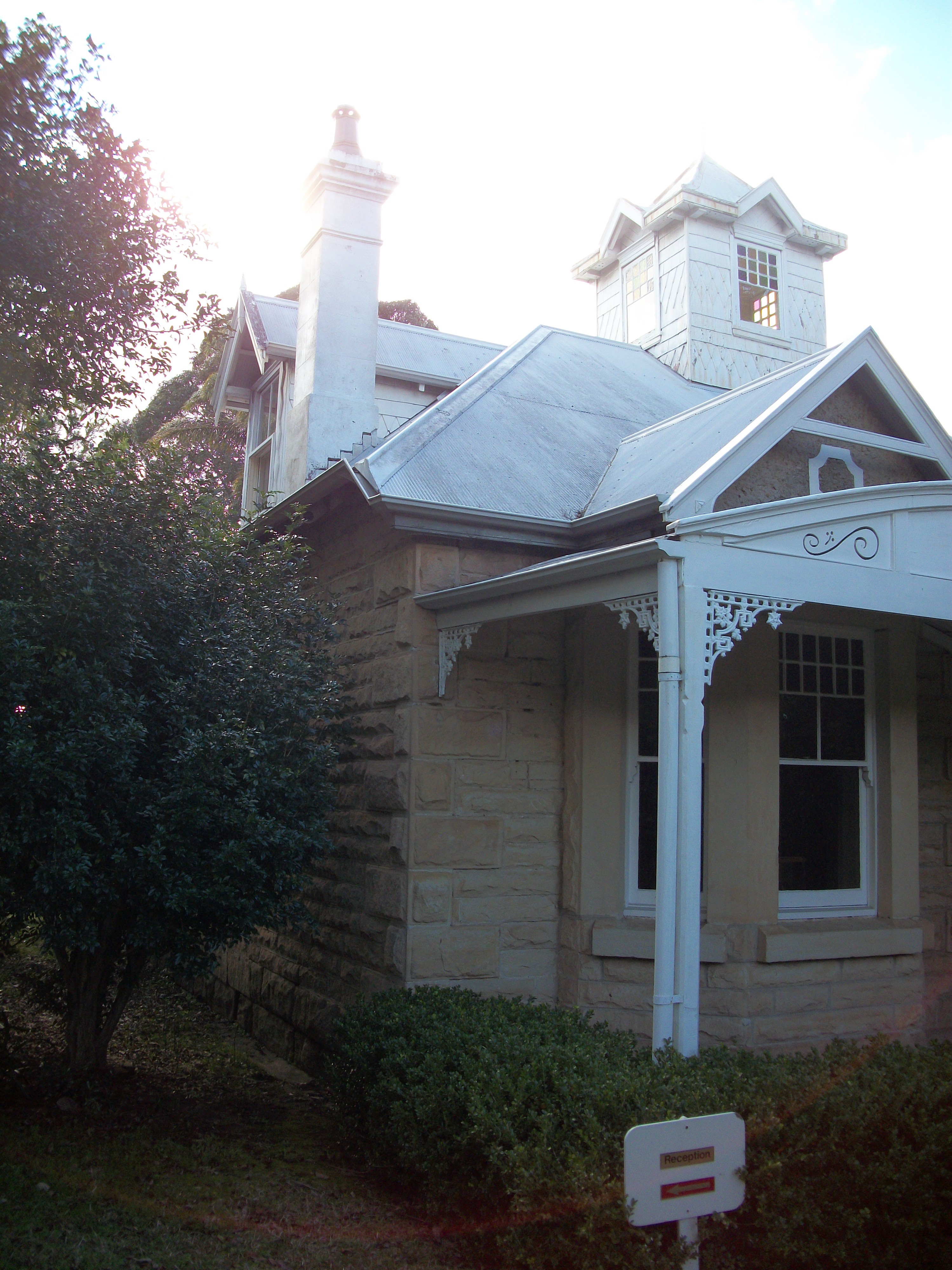
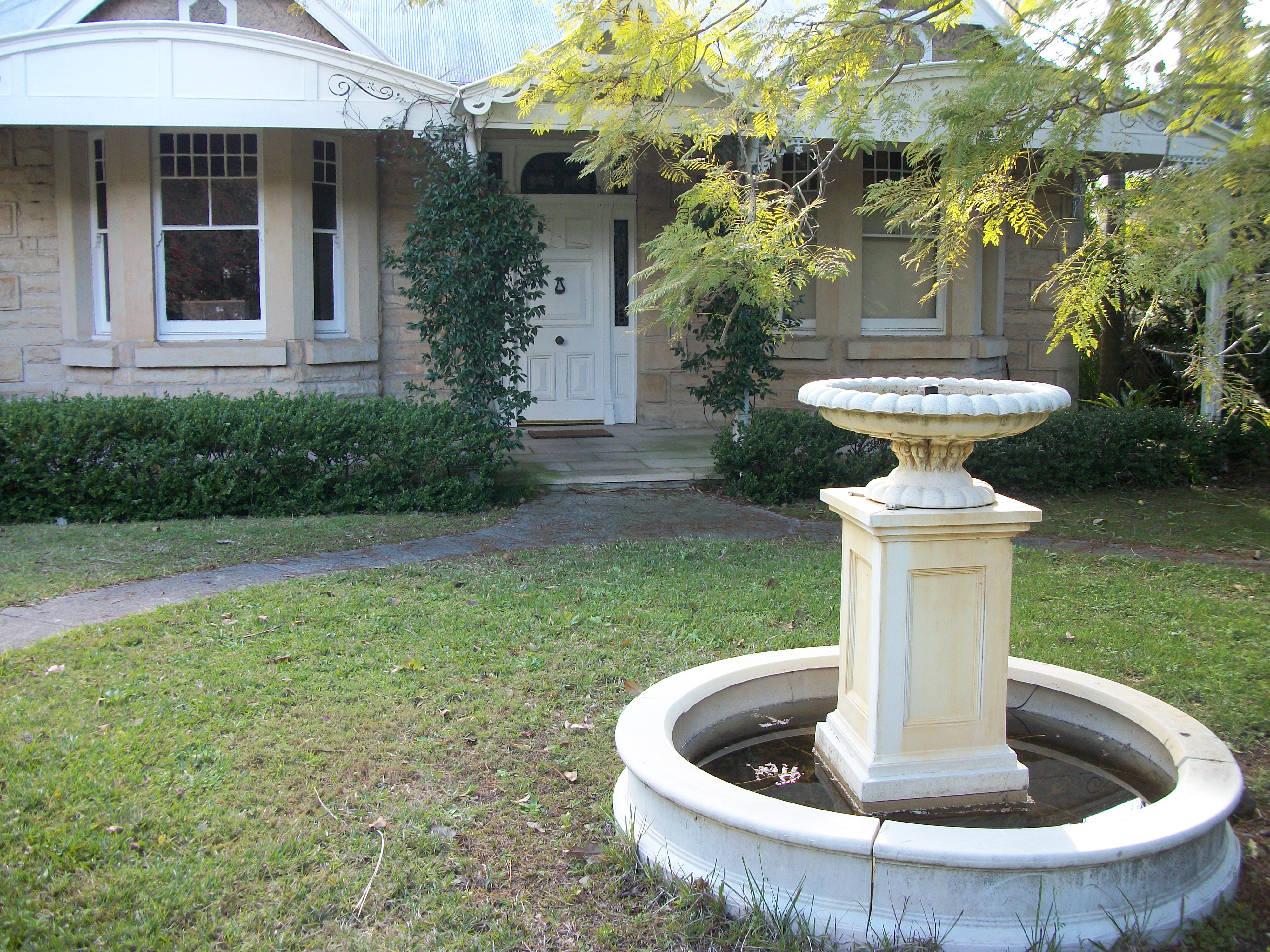
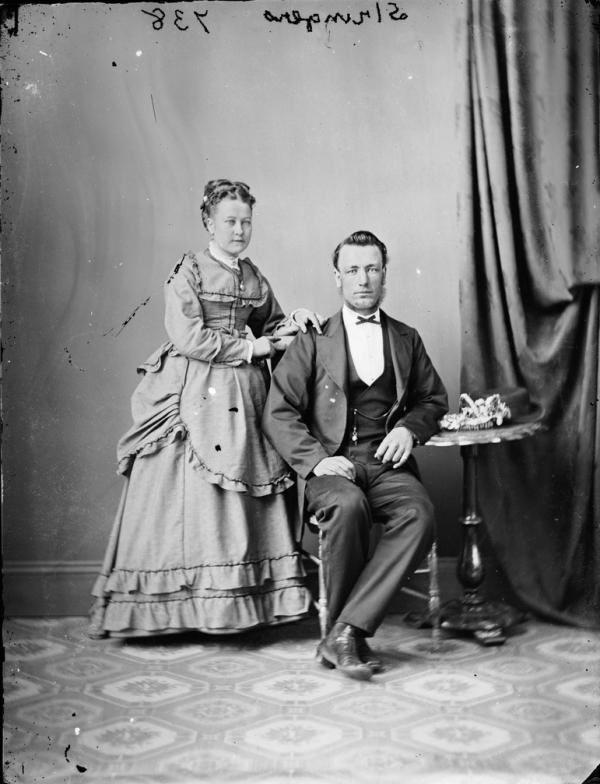
[Builder Samuel ?] Stringer and his wife [Sarah, nee Potter ?] circa 1870 -1875. Image No.: a2823823, courtesy State Library of NSW
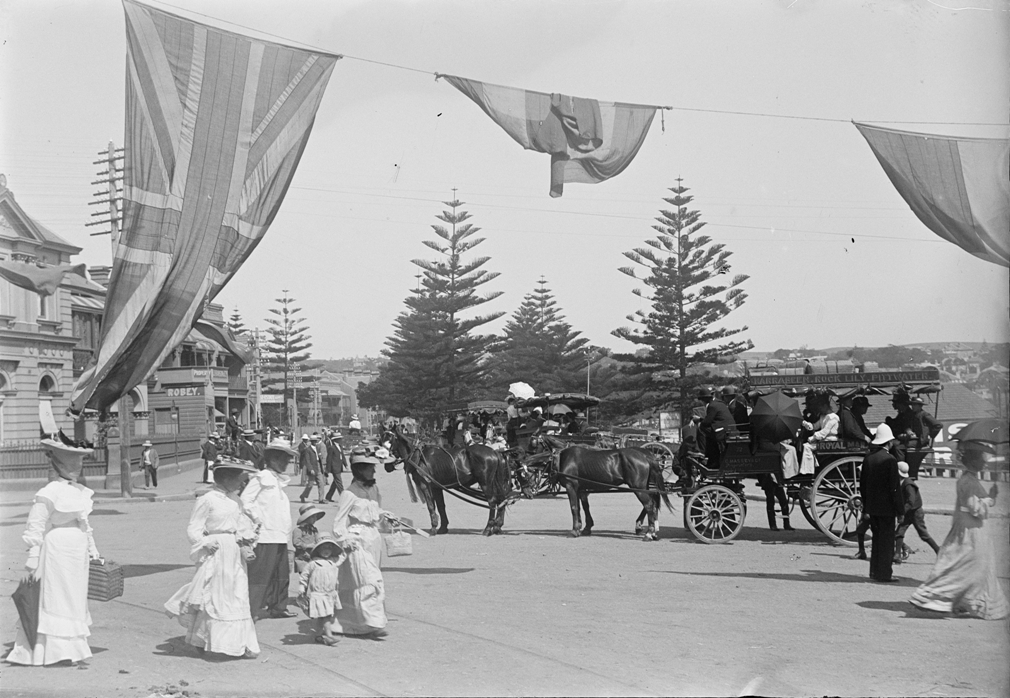
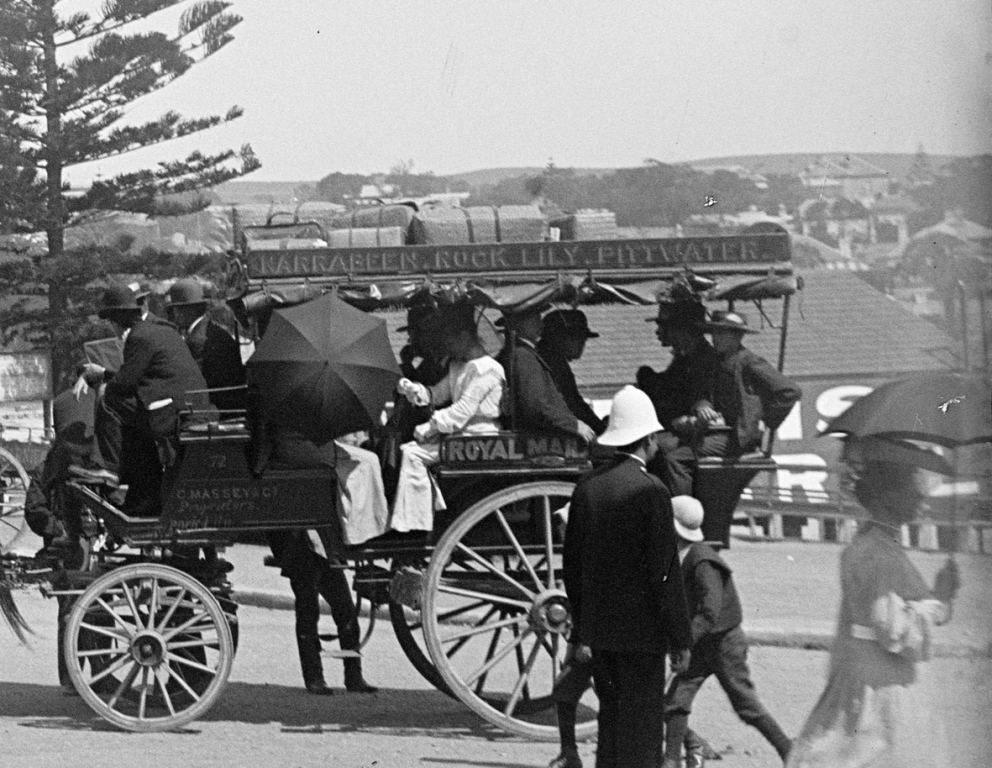
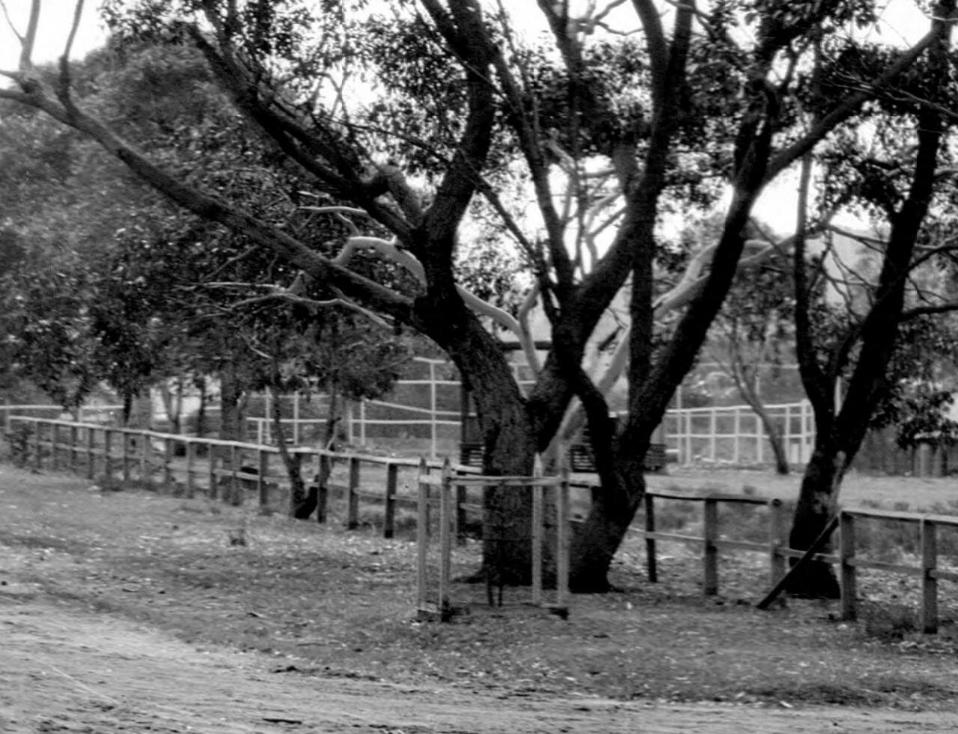
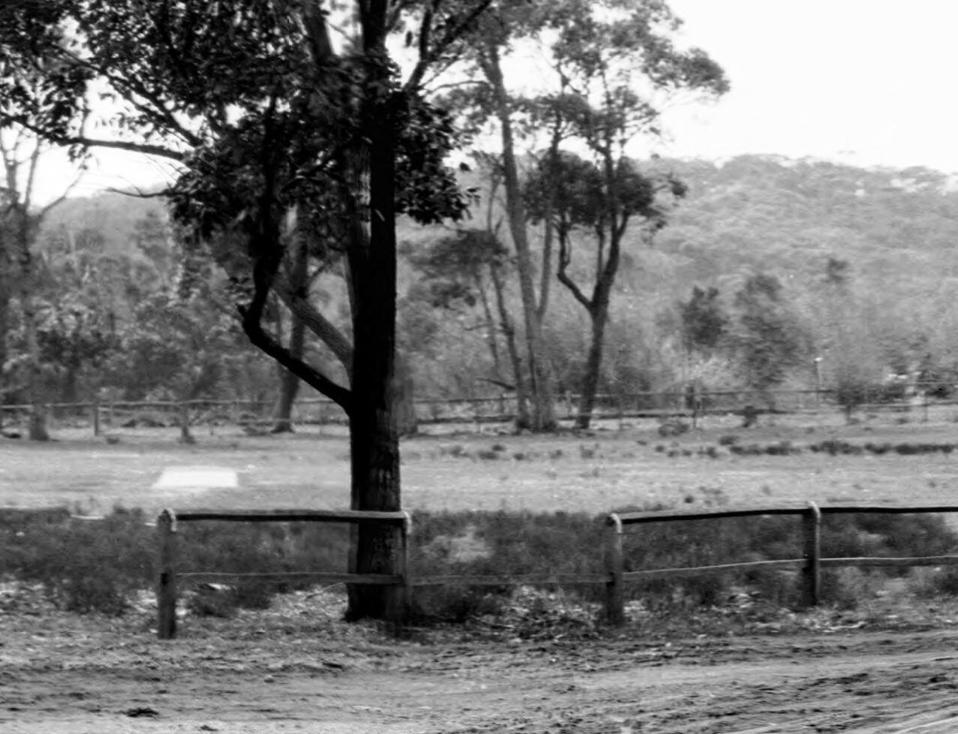
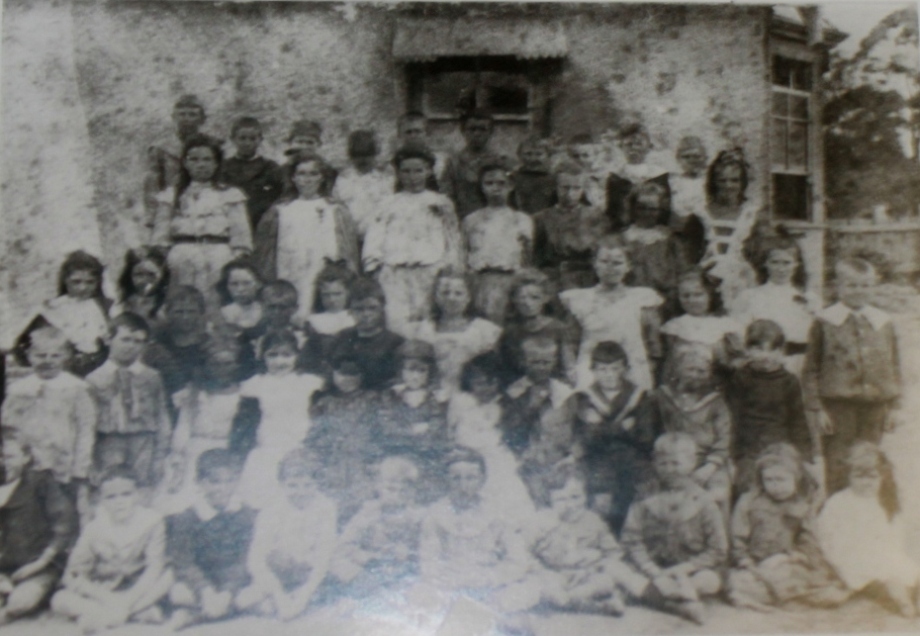
Mona Vale School in Stringers cottage, Park St, Mona Vale
“..Mona Vale had a population that demanded a Public School. Miss Stringer had opened a private school. There were too many children to convey to Bayview by coach, so the Department decided to close Bayview Public School and open one at Mona Vale. Two rooms of a new cottage belonging to Mr. Stringer were, with little difficulty, converted into fairly comfortable schoolrooms.” - Samuel Morrison.
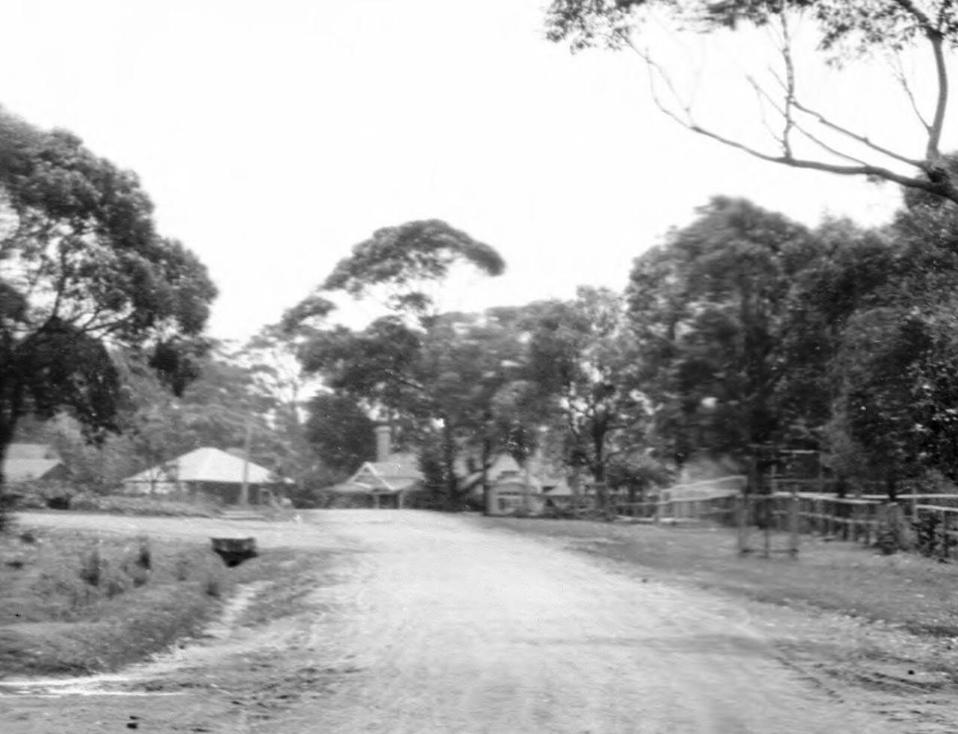
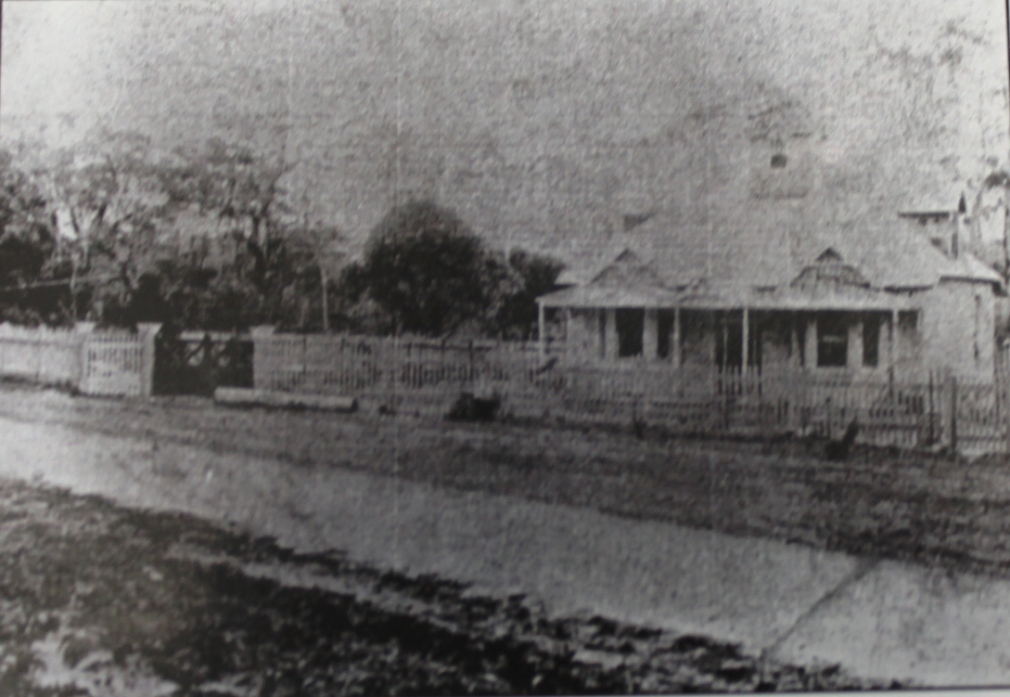
Wife’s death (per NSW BDM's): 20985/1919 STRINGER SARAH A CHARLES ANN MANLY
Samuel George Stringer:
STRINGER-The Relatives and Friends of Mrs MATILDA M STRINGER and FAMILY of 99 High street Carlton and Mr H STRINGER are Invited to attend the Funeral of her late beloved HUSBAND and their loving FATHER and BROTHER Samuel George Stringer, Junior which will leave the Private Mortuary Chapel of Mr Charles Kinsela. of 143 Oxford street Sydney THIS WEDNESDAY at 1 p m for the Baptist Cemetery Woronora, via Central Station Funeral train leaves Central at 1.46 p m and Carlton at 2 p m
CHARLES KINSELA Phone FL413S 7 B_ Hurstville
STRINGER-LOYAL CARLTON N I O O F (Oddfellows) -Officers and Members of the above Lodge are requested to attend the Funeral of our late Bro .SAMUEL G STRINCER which will take place at Woronora Cemetery THIS DAY (See family notice ) F WILLIAMS N G _W SUGGATE Secretary. Family Notices. (1932, December 7). The Sydney Morning Herald (NSW : 1842 - 1954), p. 9. Retrieved from http://nla.gov.au/nla.news-article16936092
STRINGER.-In loving memory of my dear husband and our father. Samuel stringer Junr., who passed away December 5, 1932, Peacefully sleeping, free from pain, In God's own time we will meet again, Family Notices. (1936, December 5). The Sydney Morning Herald (NSW : 1842 - 1954), p. 16. Retrieved from http://nla.gov.au/nla.news-article17297998
Samuel Stringer senr.
STRINGER.-January 3. 1933. at Hurstville. Samuel Stringer (senior), late Mona Vale, beloved father of William. Henry. Lily. Nell, and Annie
STRINGER-The Relatives and Friends of Mr and Mrs W STRINGER Mr and Mrs H STRINGER, Mr and Mrs F OLIVER Mr and Mrs T ELLIS Mr and Mrs J CLIFFORD and FAMILIES are invited to attend the Funeral of their beloved FATHER and GRANDFATHER Samuel Stringer which will leave his late residence 62 Lily street Hurstville THIS THURSDAY at 145 n m for the Methodist Cemetery Manly CHARLES KINSELA Family Notices. (1933, January 5). The Sydney Morning Herald(NSW : 1842 - 1954), p. 7. Retrieved fromhttp://nla.gov.au/nla.news-article16943261
section of Squire Mural in family collection
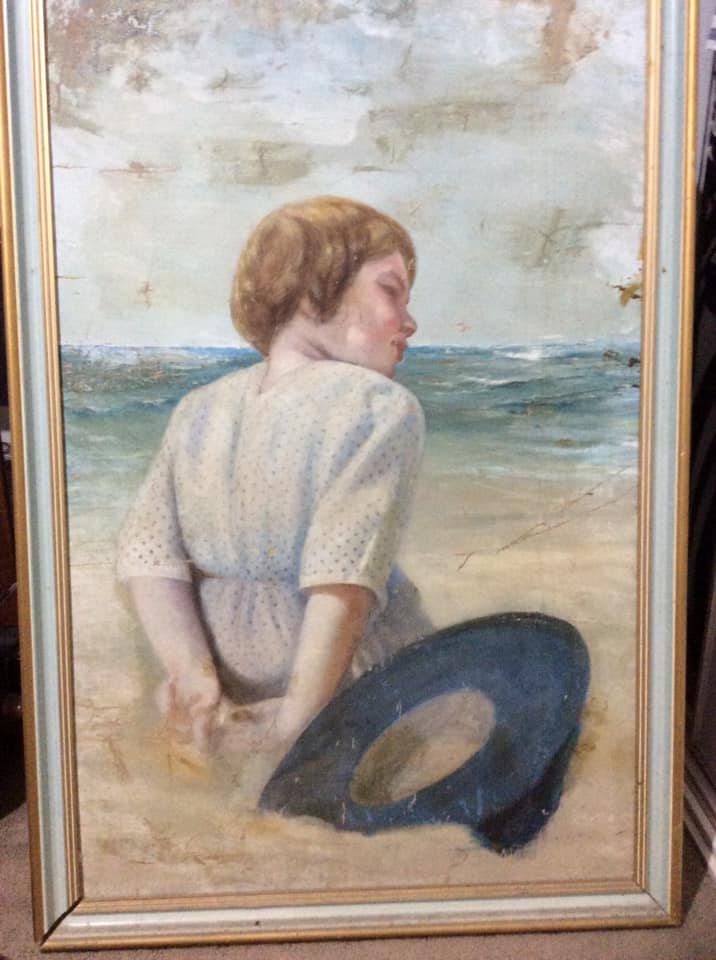
''I am Fred Thompsons' grandson and spent much of my youth living at 28 Park St. Fred bought the house in the 50s I believe at auction it was in need of a lot of work. Being a carpenter/cabinet maker and many other skills it suited him well. I remember him renovating room by room, adding a laundry and generally bringing it back to its former glory.As I look at the current picture I recall bamboo along the driveway which wasn’t paved back then, with loquat trees and Chinese gooseberry also. At the end of the driveway was a very large mulberry tree and beside that a large shed which Fred used for storage and woodwork.There were many statues throughout the property, aboriginals standing by trees, kangaroos, birds etc, I believe but can’t be sure that the cart and bullock from Shaws was originally from there as well. I remember the statues were concrete like chicken wire and then concrete over.The picture I have was given to me by mother Gloria it was part of a mural of a beach scene of Mona Vale. Unfortunately I don’t know who it is or when it was painted but remember it was on the wall in the largest room in the house and the mural took up the whole wall. I believe the rest was in poor condition and needed to be removed or covered over during the renovation.The house was used occasionally for TV, I remember a commercial being filmed there and of course it was photographed by many.On the Bayview side was Dr Spence, and 26 Park St another beautiful old house who I remember two older ladies lived in and I think there names were Ivy and Violet, I used to go visiting for cordial and cake as a kid.''
''Larry gives a good description of the place. The painting was on canvas and fitted to the loungeroom wall which had a beach mural so that it appeared as though it was all one mural. Grandad (Fred) took the canvas down and rolled it into a tube as when we moved to Queensland he had plans to sell the house. The murals were peeling.In my bedroom was a semi relief plaster figure of a woman, absolutely beautiful. The statues of aboriginal children and adults were, as Larry said, chicken wire stuffed with newspaper and concreted over, very life like and life size. I have a few photos in mums stuff (sadly passed in 2019) that I could share with you.[We have requested these and Glenys will get them to us over the next week or so - thank you Glenys - Ed./PON]Grandad said the Squires used to travel to Queensland a lot and evidence of this could be the travellers palm that used to be in the front yard. In addition to that photos were in the house when grandad bought it of indigenous peoples.I have looked at photos of the house when it was on the market before and must admit I much prefer how it was when we lived there.I have many memories of us kids climbing the massive mulberry tree that was in the back yard close to the kitchen and mum (Gloria) making baking tray sized mulberry pies. There were also mature plum and fig trees in the back yard.''
The H. T. Squire sculpture entitled 'Peter and the water Buffalo' has a bit of a story that goes with it. In ‘Mona Vale Stories', compiled by Guy and Joan Jennings (2007) it is recorded that an elderly farmer Mr. Rundle, who had a roadside fruit and vegetable stall, wanted to improve sales and, as he had previously lived in Darwin and had employed an indigenous Australian by the name of Peter to transport his produce on a cart pulled by a water buffalo, came up with the idea of making a sculpture of the same for his stall.
Harold Squire was commissioned to make the statue. However, this didn’t work out for Mr. Rundle, who then on sold the statue of Peter and the Water Buffalo to a Mr. Noble, who had a better site, and perhaps could get permission to install the sculpture.
A Life-like Model of a Water Buffalo.
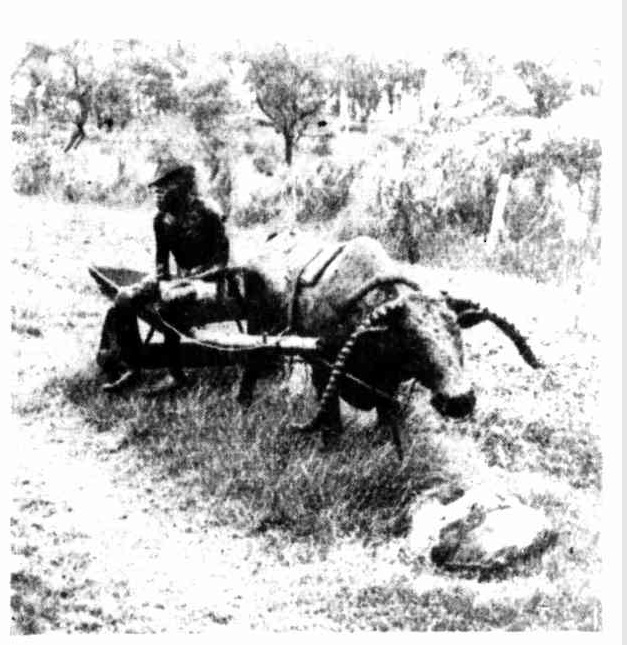
THIS realistic -looking water buffalo and its driver stand near a road-stall on the Pitt water Road, Mona Vale (near Sydney), and are seen by thousands of motorists driving to Palm Beach every week. In the vicinity are many other models — of elephants, kangaroos, flamingoes; in fact, all kinds of animals and birds equally as life-like. Most surprising is the life-size model of an aboriginal standing with poised spear among the bushes at the end of a little-used paddock. The models are the work of a local artist. — N.G. A Life-like Model of a Water Buffalo. a survey and Some Opinions (1938, March 30). Sydney Mail (NSW : 1912 - 1938), p. 6. Retrieved from http://nla.gov.au/nla.news-article166229605
Harold's works were still appearing in newspapers and remain, in Peter and the Water Buffalo, and the Bayview Golf Club elephants on Hole 18.
They are part of the places he once strolled through and a tribute to those who came before us, marked with respect in the case of Bayview Golf Club and perhaps symbolic of the friendship between the Orrs and the Squire couple, who had been married for close to 48 years by the time Harold passed away, and had been among some of the great shifts Australia went through from the 1850's on.
GLASS-HOUSE TOMATO-GROWING AT MONA VALE.
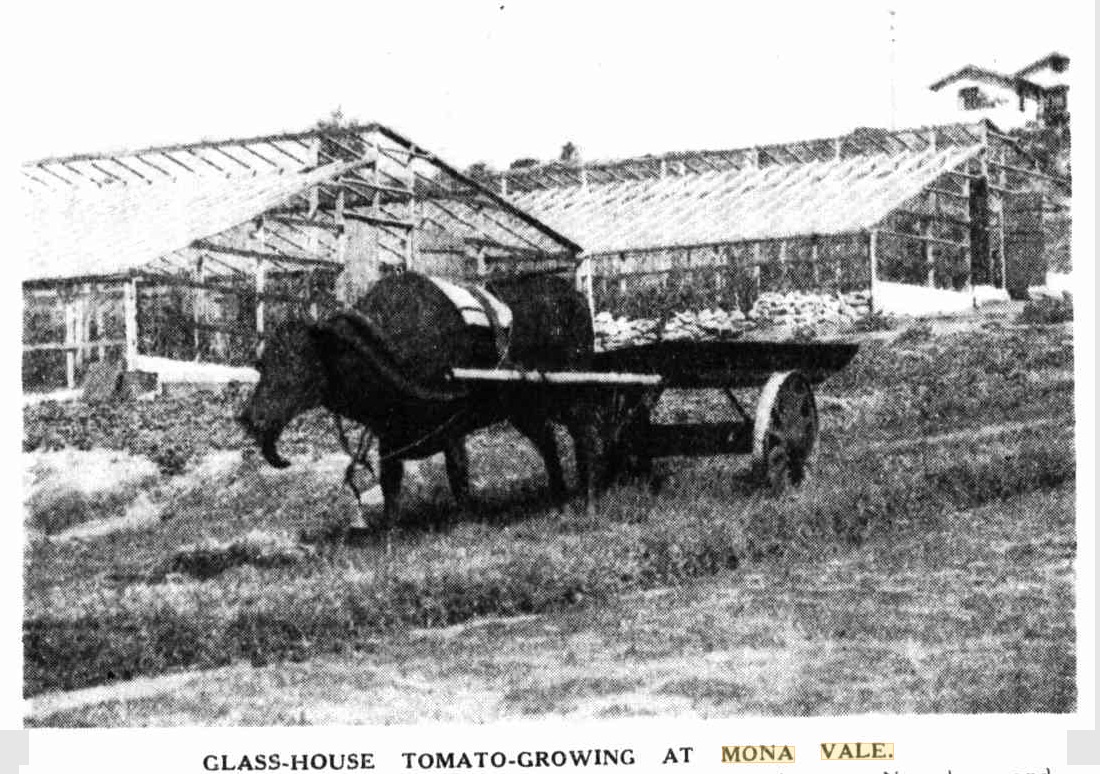
Large quantities of early tomatoes are grown at Mona Vale, between Narrabeen and Newport, Sydney, the glass-house system there having proved very successful. Disease has to be guarded against by stringent precautions and treatment, but, with clean crops, the returns are highly remunerative. The buffalo in the picture, although wonderfully realistic, is made of cement. GLASS-HOUSE TOMATO-GROWING AT MONA VALE. (1938, November 2). Sydney Mail (NSW : 1912 - 1938), p. 39. Retrieved from http://nla.gov.au/nla.news-article166526289
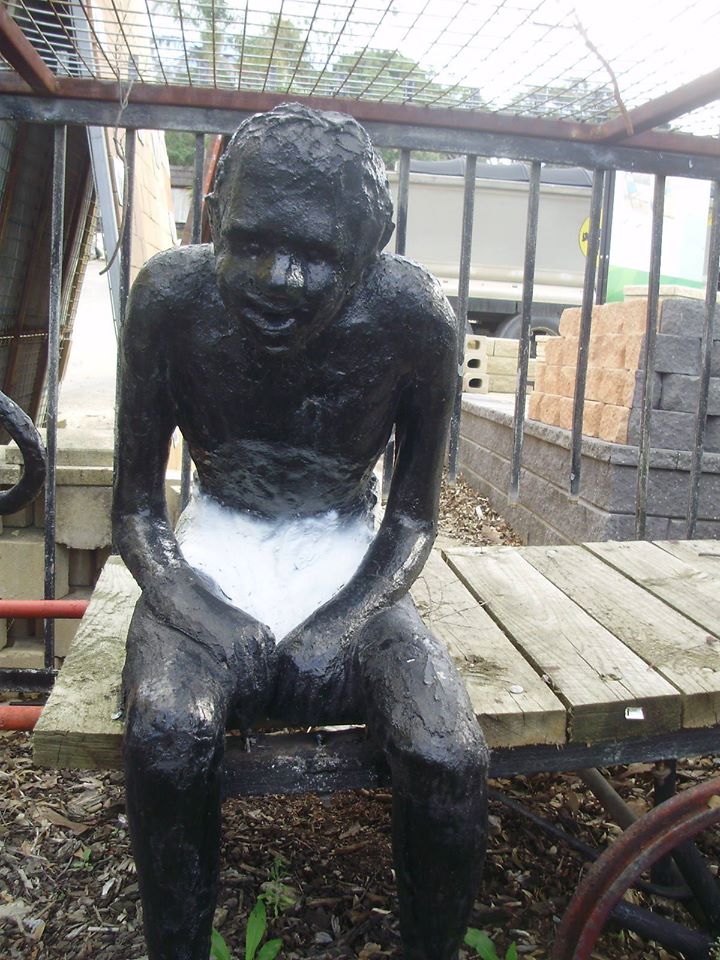
''Peter'' in 2011 at Shaws photo by and courtesy Dave Murray
The family group of elephants still intact on Bayview Golf Course are also Harold and Mabels':
Future History Insight Into Aboriginal Art In Pittwater
MONA VALE SCULPTOR'S NOVEL ART IN CONCRETE
At Work on Life-sized Mob of Elephants
Descendant of a family of artists and sculptors, Mr. H. Tristram Squire, of Mona Vale, has turned his ability as a modeller and sculptor in a novel direction.
His home is full of statues in concrete, and a big group on which he is now engaged is that of a life-sized mob of elephants. A flamingo in concrete causes the visitor to pause at the front gate, and a jackass and frilled lizards fraternise with life-like rabbits. Mr. Squire's plaques in concrete are in demand, and he is kept fully occupied at his work.
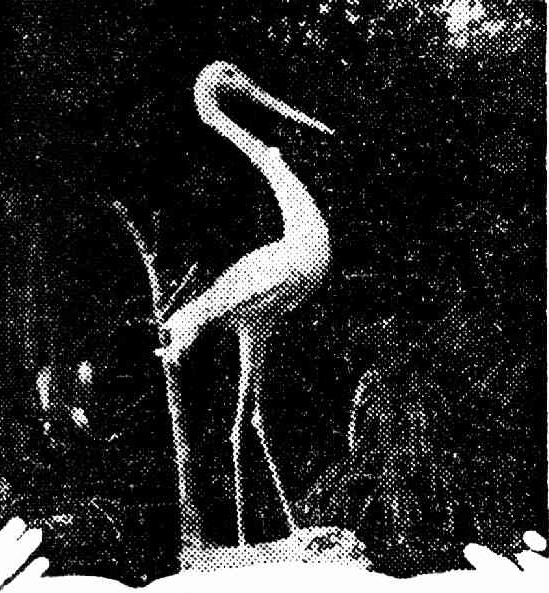
IT WOULD TAKE a big gun to scare this flamingo from his perch. He is a concrete bird.
MONA VALE SCULPTOR'S NOVEL ART IN CONCRETE (1930, May 15). Daily Pictorial (Sydney, NSW : 1930 - 1931), p. 13. Retrieved from http://nla.gov.au/nla.news-article246185285
An extract from Mr. Wheeler's Early Days of Bayview provides a physical description and some of those he recalled being in these places;-
At the head of the bay is the Newport “Maze,’’ a channel running into a tangle of mangroves, finishing in a swamp up near Bayview Road. A book of adventure — Drowning Maze —was written about this area by Miss Jean Curlewis. The Sydney Morning Herald commented as follows:
Visitors to Pittwater are acquainted with the intricate tangle of scrub and channel at the Newport end, but they probably have no suspicion of the exciting things that happen in this eerie locality. Miss Curlewis lets them into some of its intriguing secrets.
To the west of The Maze is Shaw’s Creek. I often saw old Jack Shaw stealing along silently in his ketch about dusk up McCarr’s Creek, like the “Old Grey Man of the Sea.”
.....
After traversing the terrain outlined in the preceding paragraphs, I gathered that Governor Phillip and his party camped on the evening of August 24, 1788, half a mile to the south of the lofty eminence which towers above Bungan Beach. There is a long vale in this locality situated just to the north-west of Bongin-Bongin, or, as it is now generally called, Mona Vale Beach, and many Cabbage tree palms are still to be seen there. Phillip and three members of his party walked to the top of the eminence (now called “Bushranger” trigonometrical survey station, 321 feet) just before dusk, and saw the southern part of Pittwater extending from Winnijimmi (Newport) to Church Point. The freshwater river that they explored the next day would be Shaw’s Creek, Bayview, and the swamp in which it took its rise was known one hundred years ago as Winnereremy. A map in the Department of Lands shows the entrance to that creek as Winni Jenny, and this name and Winnijimmi are probable corruptions of Winnereremy.
.......
Close at hand is the home of Mr and Mrs James Shaw, pioneers of the district. Mrs Shaw, who was formerly Miss Ann Oliver, was born on the peninsula, Lovett Bay, in 1856. Before that, her father, William Oliver, lived in a cottage on Cape’s Flat, near the Fig-tree, the site of which has been swallowed up by encroaching tides.
Mrs Shaw told me that she had a vivid recollection of a black fellow spearing fish under a mangrove on the point of the flat just below Baker’s orchard. That was when she was a young girl. “I can see that blackfellow now,” said she, “with the fish quivering on the spear just as I see the leaves shaking on that tree.”
On the bank of the small creek near the Bayview Post Office a blackboy who nursed her brother Tom was buried. Mrs Shaw said that probably the grave was covered over when the road was made to Church Point.
Local anecdotes state this gravesite was on the Roche property at Bayview, and that this unnamed First Nations man had been well-known and well-loved in the Bayview-Church Point and Bayview areas. The story handed down to children of these earlier residents state the reason this occurred was the unnamed gentleman, obviosuly a part of the community for years by then, could not be placed in the cemetery at Church Point.
Other records in the pages of the past newspapers record that similar burial sites of the local First Nations peoples occurred alongside creeks at Newport and Mona Vale, and in sand dunes.
Clearly there was a cultural practice of doing this for the Indigenous peoples of Pittwater.
Others on record in the newspapers of the past show a burial site in then named Noble Street at Mona Vale, current day Seabeach Avenue
A few of those Newspaper records:
HUMAN SKULL FOUND.
While engaged in excavating foundations for the new dressing sheds at the Mona Vale beach yesterday afternoon a workman unearthed a human skull, presumably that of an aboriginal. The skull has been forwarded to the City Morgue. HUMAN SKULL FOUND. (1928, October 5). The Sydney Morning Herald (NSW : 1842 - 1954), p. 14. Retrieved from http://nla.gov.au/nla.news-article28051655
ABORIGINES' BONES.
An old aboriginal burying place was discovered by workmen making an excavation at Newport Beach yesterday. An almost complete skeleton was found about 8ft from the surface, and another collection of bones was turned up nearby. Constable Huckins, of the Narrabeen police, took charge of the remains. ABORIGINES' BONES. (1933, March 9).The Sydney Morning Herald (NSW : 1842 - 1954), p. 8. Retrieved from http://nla.gov.au/nla.news-article16967172
ABORIGINAL: Mona Vale Skeleton
A skeleton of a man unearthed yesterday in Noble-street, Mona Vale, is believed, by the police, to be that of an aboriginal. The area where the skeleton was found was once used by the aboriginals as a burial ground, and during the last few years several other skeletons have been unearthed. The skeleton was removed yesterday to the city morgue. ABORIGINAL (1935, January 5). The Sun (Sydney, NSW : 1910 - 1954), p. 3. Retrieved from http://nla.gov.au/nla.news-article230272317
SKELETON ON BEACH
A human skeleton was discovered in a channel at Newport Beach yesterday afternoon by two set of twins, John and Peter Morris, 14, and their sisters, Judith and Joan, 8.
"Look what I found," said John, excitedly thrusting the head of the skeleton in the face of a woman on the beach. The woman fainted with shock. Police say the bones have been there for years. They may be the bones of an aborigine. SKELETON ON BEACH (1942, April 5). The Sun (Sydney, NSW : 1910 - 1954), p. 7. Retrieved from http://nla.gov.au/nla.news-article231763395
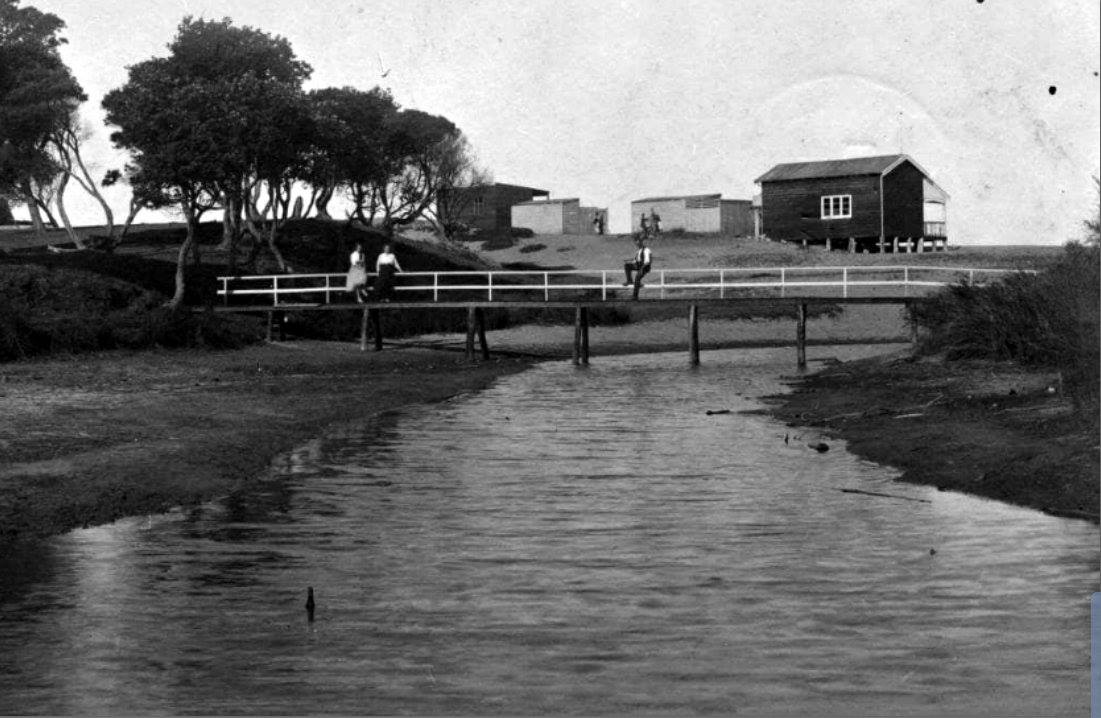
Newport lagoon - circa 1910 1900. Photo courtesy Newport SLSC
SKELETON PROBABLY 100 YEARS OLD
The action of the sea, assisted by the recent flood rains, on Saturday unearthed a human skeleton in a channel near the Newport Beach. The bones were examined by the Government Medical Officer, Dr. Percy, at the City Morgue yesterday, and he expressed the opinion that it was the skeleton of a female aboriginal, and had probably been buried for at least 100 years. SKELETON PROBABLY 100 YEARS OLD (1942, April 6). The Sydney Morning Herald (NSW : 1842 - 1954), p. 7. Retrieved from http://nla.gov.au/nla.news-article17816956
A GRUESOME TOY
Erosion of a dry creek bed at Newport during the recent rains was responsible for exposing a skeleton, which was later decided to be that of an aboriginal woman who died at least 100 years ago. The remains were found by some children who played with them for some time, till one, tiring of the game, thrust the grinning skull into the face of a woman visitor to the beach. The shock proved- too much, for her, and she fainted. The police were notified and took charge of the bones. A GRUESOME TOY (1942, April 11).Molong Express and Western District Advertiser (NSW : 1887 - 1954), p. 4. Retrieved from http://nla.gov.au/nla.news-article140104755
ABORIGINAL WOMAN'S SKELETON DUG UP
The skeleton of an aboriginal woman, probably buried many years ago, was found at Mona Vale yesterday. The spot where the bones were found was an old aboriginal burying ground. ABORIGINAL WOMAN'S SKELETON DUG UP (1945, September 10). The Daily Telegraph (Sydney, NSW : 1931 - 1954), p. 7. Retrieved from http://nla.gov.au/nla.news-article248023953
There are no markers at either Newport or Mona Vale beaches paying tribute to these old sacred grounds for our local First Nations peoples. However, snippets from yet another past newspaper report provide, although it should be noted Shelagh and George Champion, after extensive research, sated the 'tale of Ben Squires and Jane Dalton' is false and never took place. The 'bungie bungie' is also referred to in other records as the 'Bongin Bongin' meaning 'lots of shells' (possibly middens) as a name given to Mona Vale Beach, particularly the Basin part of that shorefront, and had not been recognised as the name for Bungan Beach at that stage:
THE CONTRIBUTOR
A GLORIOUS OUTLOOK NEAR SYDNEY.
BY A QUEENSLANDER.
.............
Beyond that point is a small beach ending in Narrabeen Head, the 'Guarrabeen' of the blacks, the name of the honeysuckle. Beyond these are two more romantic headlands, and then the sheer precipice of Bungy Head with its grey, white, and yellow sandstone, at the foot of which lie confused enormous boulders, torn down by the wild surf that has assailed the rugged rock fortress since a dark unrecorded morning when man was not.
This wild foreland received its present name in 1815 from the blacks who called it m 'Bung-gie Bung-gie' their name for a musket and the noise of the report, because ten of their people were shot there by a party of soldiers sent out to bring in a convict man and woman, Ben Squires and Jane Dalton, who had lived at peace with the blacks for five years.
Behind 'Bung-gie Bung-gie' rises 'Bushrangers Hill,' the 'Bannaweera' of the blacks, from 'banna' rain and 'weera' bad, literally much rain, or a bad place for rain. This is the site of another trignometrical station, the height of which is 221 feet. Beyond 'Bung-gie' is Bulgolo Head, and also the bays and headlands ending in the lofty promontory of Barrenjoey, and beyond that the dark blue outline of the Three Capes. Looking still further, we see the hills of the Barrenjoey Peninsula, all the hills of Kuringai Chase, the blue and beautiful harbour of Pittwater, all the hills in which that harbour is embosomed, all the grey and green hills ribbed with grey and white standstone stretching west, the blue Narrabeen Lake and the hills by which it is encircled— all these are spread before you in the north and west head eastern view from that remarkable hill only four miles from Manly.
Look south once more, and you see the whole city of Sydney from the South Head to the heights of Balmain. And far away in the background, out on the horizon, rises that once dark, mysterious range that barred the white man's pathway to the interior, where 95 years ago the vast solitude was first trodden by Wentworth, Blaxland, and Lawson. That range seems to 'watch and wait always' and to-day It has the same colour that suggested the name by which it shall ever be known, the 'darkly, deeply, beautifully blue in which those mountains appear from the crest of the Manly hill. Now we come to the historic romance of that sandstone-covered Beacon Hill. In the year 1795 or 1796 a transport called the Britannia came out with convicts, among whom as a, young red-headed Scot named Wilson, who escaped a month after he landed, and finally trusted himself among the blacks from Manly to Pittwater. A man with red hair was safe among any tribe of Australian wild blacks. Wilson lived for years with the blacks, who called him 'Boonbooi' and 'Moojellba,' from Moojell, red. When he came in and surrendered he was naked, and tatooed with the 'wirroong' and 'cong-arri' scars (the 'Moolgarra' of Moreton Bay). The Governor made use of Wilson's aboriginal knowledge of the country and the blacks, and sent him out with exploring parties. Wilson shot the first known specimen of the lyre bird (Menura superba) somewhere in the Illawarra district. Finally after many adventures he took a woman from the Pittwater tribe without her parents' consent, or even her own, trusting that his possession of a gun would save him. Her relatives followed, caught him in the embraces of his dark Diana, and killed him. The Manly hill was Wilson's favourite lookout. From there he could see signal fires made by convict confederates north to the Hawkesbury and Barrenjoey, and south to Sydney and Botany.
On the tableland coming down from the hill, on a level spot, is the site of a once favourite corroboree ground, and the Deewhy headland, the site of an ancient bora circle. Boonbooi's lookout was used for the same purpose by the blacks. At this spot during a corroboree he would meet such a well known old-time blacks as Colbee, Mooroobra, Booroowanyee, Yemerrawanni, Beemulwy, Boonggarie, and the famous Benillong, whom the Governor took to England, and brought back in H.M.S. Reliance. Think of the wild, weird scenes on that tableland a hundred years ago. The wild men dancing in the firelight and singing, while the wild women beat time on the stretched opossum rug or on the hollow thighs. Around them the dark rocks and the silent trees, with no other sound save that of the incessant moan and wail of the sea, where the waves died on the beach or dashed themselves on the rocks and over all heaven's azure roof, studded with silver stars. Today that old wild race is gone.
The white man looks from Boonbooi's hill, where the eagle eye of the savage once scanned the far horizon for the smoke of the signal fires, and sees, not the bark canoes and the dark spearmen watching the track of the fish, but mighty steamers going and coming to and from all the nations of mankind, and the white-winged ships that in the words of Kendall, 'look like sheeted spectres fading down the distant sea.' He sees the children sport upon the shore, And hears the mighty waters rolling evermore. But who shall explain how that look-out of Boonbooi, or Moojellba, has wisely been made a reserve, and so escaped the speculator, the land agent, and the auctioneer, who could have exhausted all his eloquence and pictorial art, and still been far short of the reality? And how is it that there is not a tram from Manly to Newport, and hundreds of people settled along that beautiful coast? That is to a visitor a truly astounding conundrum. That surely must soon be the popular route to and from the Hawkesbury and Pittwater, the most attractive of all your tram routes and seaside resorts, and Sydney's most beautiful marine suburb.
On my first visit to Beacon Hill I was accompanied by W. B. Dalley, B. D. Morehead, and two English visitors. Dalley objected to the climb, and expressed a wish for the wings of Pegasus, or even those of Daedalus and Icarus. Once on the summit he expressed himself in raptures, declared it was a suitable site for the temple of an Australian Diana, and that no meaner beverage than nectar or nepenthe should be quaffed there. The nepenthe on that occasion was made in Scotland. Today a majestic palm stands on the shores of a serenely beautiful little bay between Bungan and Bulgolo points to mark the spot where Sydney's eloquent and classical son sought the companionship of the ocean and rest from the turmoil of the city. THE CONTRIBUTOR (1909, December 1).The Sydney Mail and New South Wales Advertiser (NSW : 1871 - 1912), p. 5. Retrieved from http://nla.gov.au/nla.news-article165737545
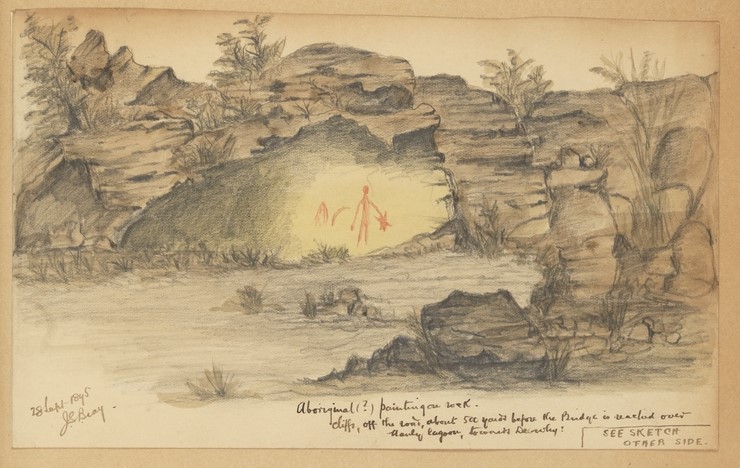
Aboriginal painting on rock / cliffs, off the road, about 500 yards before the Bridge is reached over Manly Lagoon, towards Deewhy 28 September 1895 By James Samuel Bray; page 8. Item: c004070012h courtesy Mitchell Library, State Library of New South Wales
First Nations peoples, or those Harold Tristram Squire made contact with in his long and winding path to Pittwater's Mona Vale, may well have been the models for Harold's Aboriginal sculptures. Another few examples:
Why The Spear Was Stayed —
STORY OF GRIT AND SILENCE
"EVERY muscle tense, an aboriginal chieftain stood poised over a pond in a Mona Vale garden yesterday, his hunting spear drawn back for the deadly thrust. Although the carp beneath him was an easy target, the spear was not launched, for realistic though the figure is, it is made of cement, not flesh and. blood.
He is one of the many works modeled by Mr. H. Tristram Squire, whose garden is filled with life-like representations. Kangaroo and wallaby, lizard and snake are mingled with a dozen flamingoes, whilst a group of children stand quietly looking on.
The interior of the house is no less remarkable than the garden. "Blank walls are hard and damaging to the sight," said Mr. Tristram Squire yesterday, whose walls are painted to represent land and seascapes.
"The effect of a distant scene keeps the eye at a more or less natural range." Mr. Squire told of a large, black snake that he recently made for a friend, who placed it in a natural position among some bushes in his garden. The next morning the snake was smashed by an alarmed milkman.
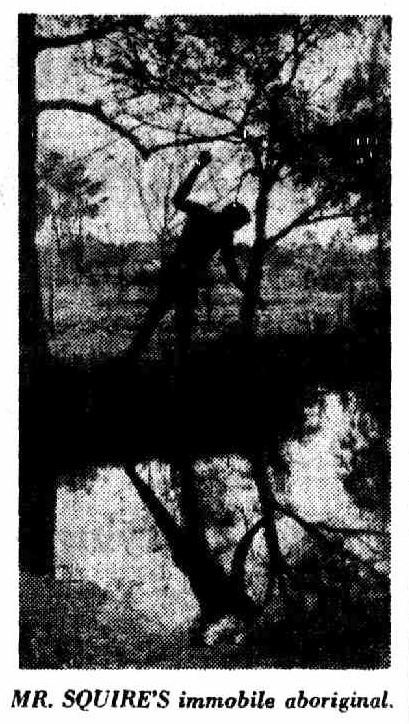
MR. SQUIRE'S immobile aboriginal.
Why The Spear Was Stayed (1935, May 14). The Daily Telegraph (Sydney, NSW : 1931 - 1954), p. 7. Retrieved from http://nla.gov.au/nla.news-article246472427
Warringah Shire Council Minutes of Meetings records one not seen since:
39. H. Tristram Squire, 9/6/37, requesting permission to place his statuary group - "blackfellow spearing water buffalo", at the intersection of Park Street, Bassett Street and Bayview Road. Resolved, - That he be granted permission. (Crs. Hewitt, McPaul)
BLACKFELLOW STATUE REFUSED
Permission for the erection of a statue of a blackfellow spearing a water-buffalo, at the intersection of Park, Bassetts, and Bayview Roads, Mona Vale, has been refused by Main Roads Board.
One reason given was that the policy of the board was against the placing of objects on the road which might distract a driver's attention. The statue is a life-size one by a Mona Vale sculptor, Mr. H. Tristram Squire. BLACKFELLOW STATUE REFUSED (1937, June 17). The Daily Telegraph (Sydney, NSW : 1931 - 1954), p. 3. Retrieved from http://nla.gov.au/nla.news-article247138983
17. Tristram Squire, 19/1/38, declining to erect his statuary in the position suggested by the Main Roads Department, but offering to remodel the water-trough at Bayview Road-Newport Road junction "combining the water-trough's utility with a handsome and-original setting'', designs of which work may be seen at his address. Resolved, - That the Main Roads Department be asked to approve of the proposal. (Crs. Latham', Batho).
More soon and HUGE thanks to Larry for the only example found so far of the work of Harold and Mabel Squire, while living at Mona Vale and of Mona Vale.
More in:
- Harold Tristram Squire: October 28, 1868 - May 16,1938 - Artist
- Pittwater Roads II: Where The Streets Have Your Name - Bayview
- Early Mona Vale Constable Owned Mona Vale Hotel Site: Some History
- Taramatta-Turrimetta-Turimetta Park, Mona Vale
- The Black Swamp Camping Reserve Becomes Kitchener Park, Beeby Park & Mona Vale Golf Course - Pittwater Creeks series opener
- Katherine Mary Roche - Pittwater Matriarch
- John Roche
- Pittwater Summer Houses: Ocean Beach House - The Combers, Newport Beach
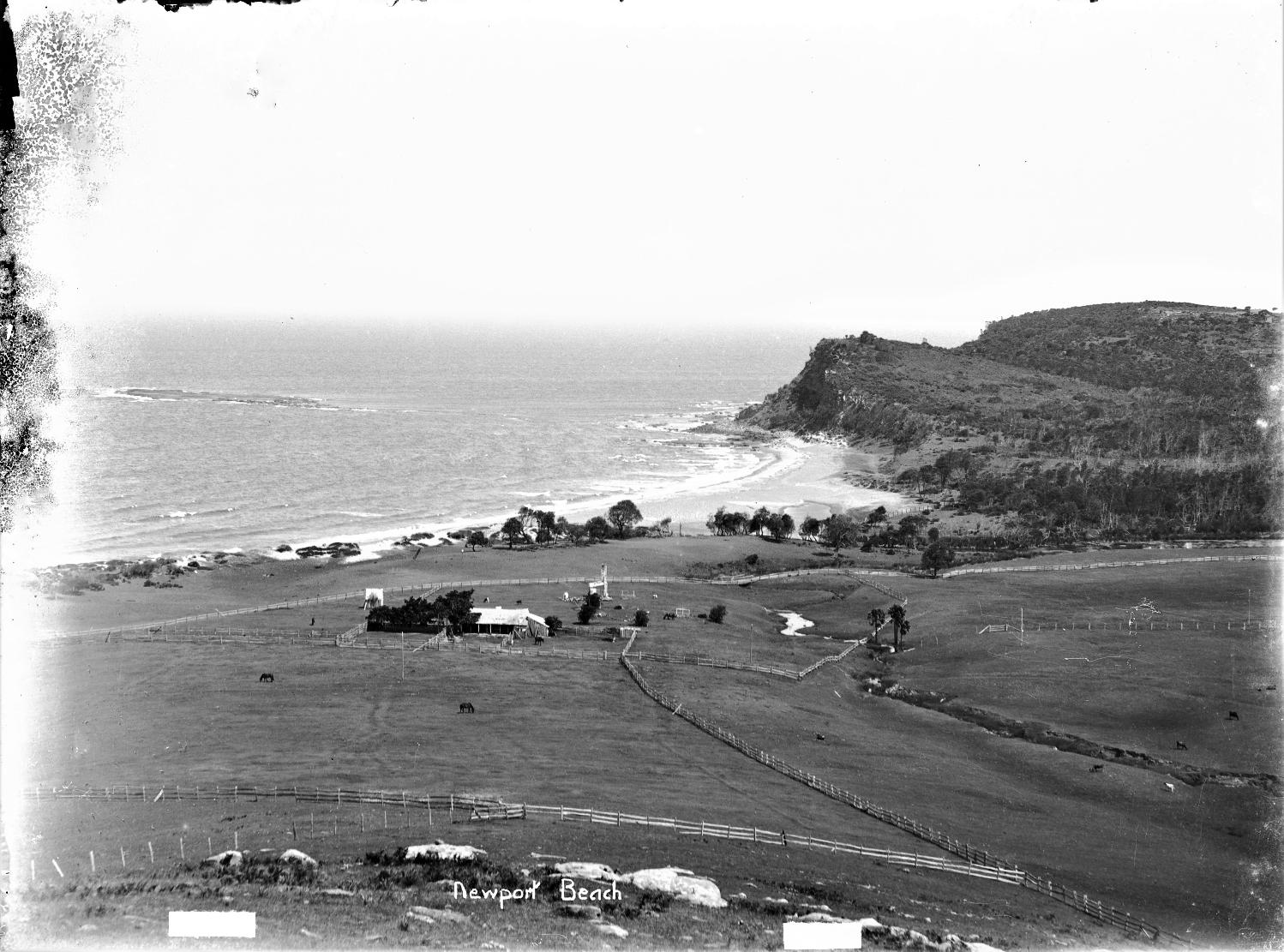
extras
CEREMONIAL ATTENDING THE BURIAL OF AN ABORIGINAL.
As the actors in the following ceremony, which we extract from the Central Australian, are in all probability doomed to die out in the course of a few years, we give the particulars insertion as a boon to history ; —
Towney, four years attached to the Bourke police, as tracker, died on Wednesday from injuries received by a kick from a horse, and was buried on the following day with all the ceremonies of his tribe.
Soon after death the body was covered with gum leaves, and rolled in an opossum-rug and a blanket. His gin lay with her head resting on the corpse, and one of the oldest men lay in a similar manner. All were silent, and remained so for twenty-four hours.
When preparations were made for the burial, two widowed gins, with their haircut short, and heads covered or plastered with pipeclay, took prominent parts in the arrangements. The oldest men earned the body to the grave (some half-a-mile from the camp) on a pole, one end resting on each shoulder, and passed through the cords which secured the blanket and, opossum-rug on the corpse. A grave was dug in the shape of a well, about 4 feet 6 inches deep.
When the grave was ready, the bier was raised by two old warriors, and at this moment a pitiful cry was raised by all the blacks. After silence was partly proclaimed, an old warrior named Kangaroo, with a small branch of gum tree in his hand, commenced addressing the corpse, "with his head close to the body. He continued doing this incessantly for 20 minutes, and was answered by an old man in a stooping posture oh the opposite side of the bier. Two men, in the grave laid an opossum-rug round it to receive the remains, which were lowered down amidst the cries of every black present. Gum leaves were then thrown over the body; and now comes the revolting part. Two men, adjusting the body in the grave, stand up. One takes a boomerang, the other stoops and receives a blow, which draws blood freely. The boomerang is handed to the other ; he then strikes, and both bleed copiously over the corpse. They are then removed, and three men go into the grave and strike each other till they bleed, bowing down their heads the while. One throws himself down, and is with difficulty removed. Three others repeat the same thing. These men all bled profusely, and in submission, till the grave was almost covered with blood. The bleeding men now retired in — and sat under trees ; the gins applied gum leaves till the ...— keeping up an unceasing cry. They submit, it seems, to their heads being cut in order to strengthen the deceased in the grave, and assist him to rise in another country, not, as is generally supposed, a white man, but a black. They carefully covered in the grave, and built a sort of gunyah over it with a bush fence round it. They swept round all the old graves, and returned to camp, leaving the wife of deceased and the widowed gins at the grave. CEREMONIAL ATTENDING THE BURIAL OF AN ABORIGINAL. (1875, February 17).Glen Innes Examiner and General Advertiser (NSW : 1874 - 1908), p. 3. Retrieved from http://nla.gov.au/nla.news-article217833305
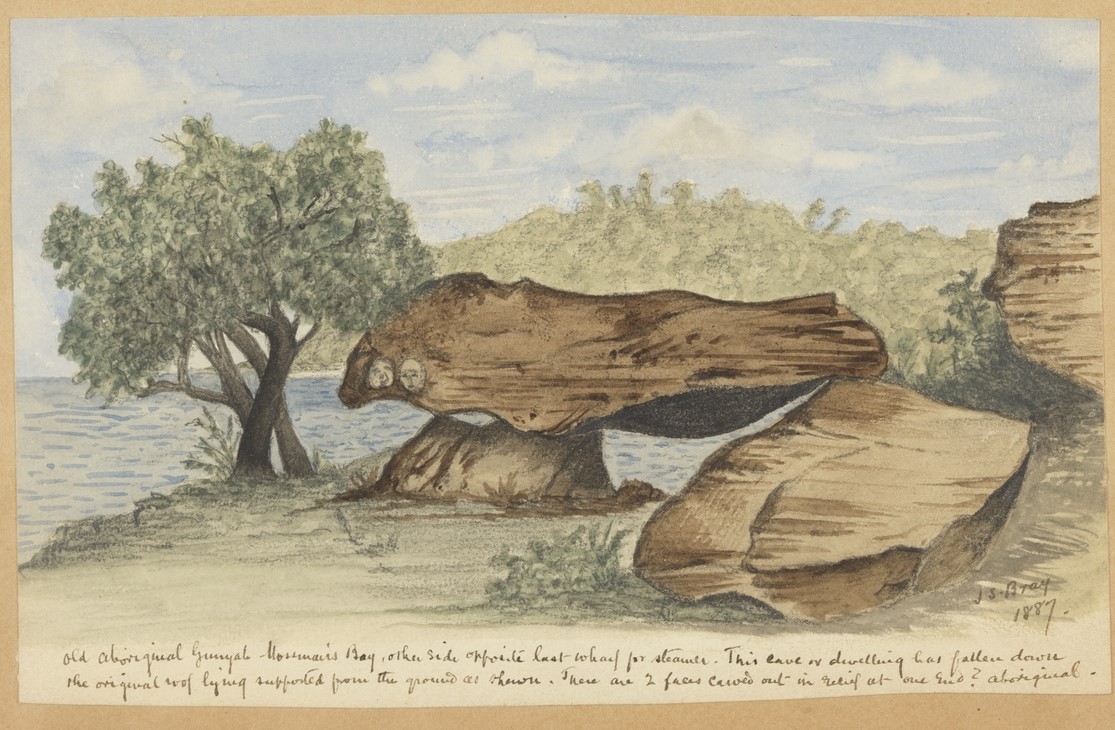
Old aboriginal Gunyah Mossman, 1887 By James Samuel Bray page 12. c004070014h courtesy Mitchell Library, State Library of New South Wales
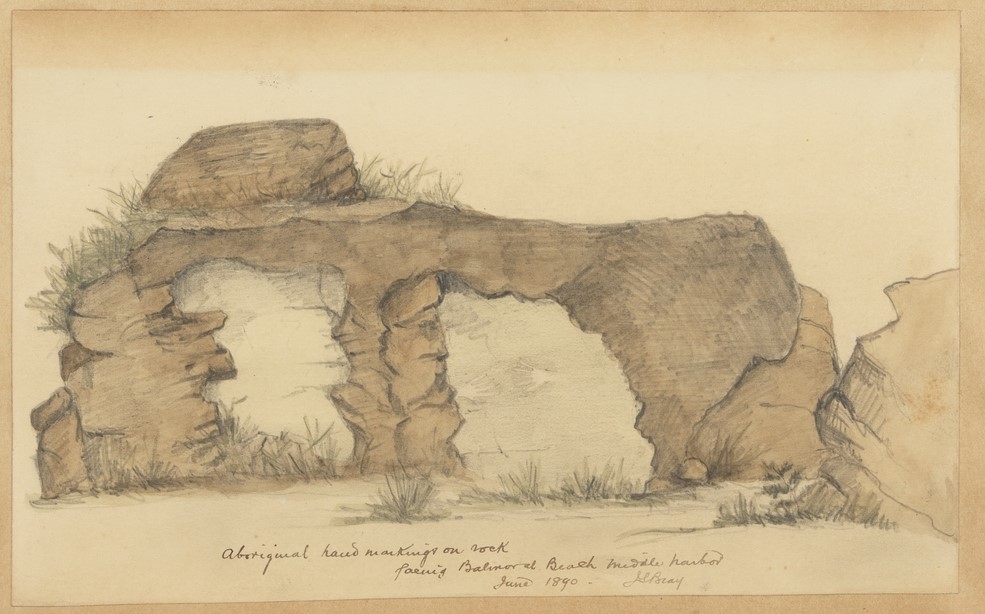
Aboriginal hand markings on rock / facing Balmoral Beach Middle Harbor [i.e. Middle Harbour], June 1890 / J S Bray [page 10] Item; c004070015h courtesy Mitchell Library, State Library of New South Wales
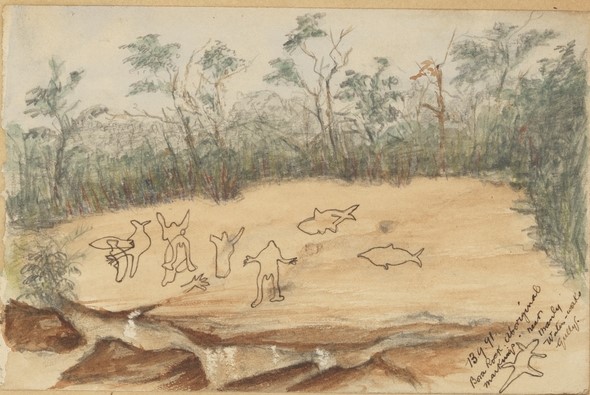
Bora Rock : aboriginal markings near Manly Water-works Gully, 13.9.1891 [page 11] Item: c004070016h courtesy Mitchell Library, State Library of New South Wales
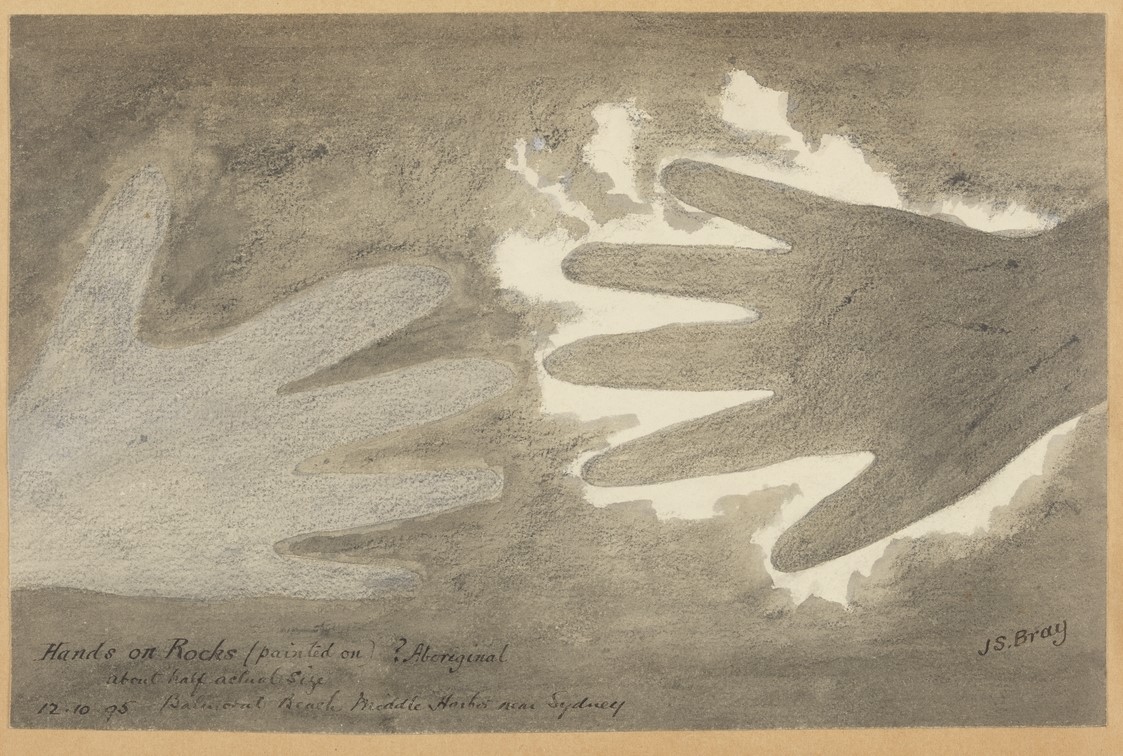
Hands on Rocks (painted on) ?Aboriginal / about half actual size / Balmoral Beach Middle Harbor [i.e. Middle Harbour] near Sydney, 12.10.95 / JS. Bray [page 2], Item: c004070007h courtesy Mitchell Library, State Library of New South Wales
James Samuel Bray was an amateur naturalist, prolific author and erratic entrepreneur in late-colonial Sydney. Through his ceaseless exploration of the city's hinterland, Bray captured the dwindling traces of its natural, Indigenous and early settler heritage. During the 1880s and 1890s, Bray's Museum of Curios traded in relics, specimens and information, connecting visitors to Sydney with his contacts across New South Wales. Despite representing the colony at exhibitions as far afield as Melbourne, Philadelphia and Calcutta, Bray perennially skirted the edges of scientific and social respectability. Often ostracised in life, and soon forgotten after his death, he nevertheless embodied the 'antiquarian imagination' that took root in the Australian colonies from the 1870s until World War I.
Sydney was on the verge of transformation when Bray was born in Bent Street on 9 January 1849. His father – also James Samuel Bray – was an English 'oil and colour man' who arrived in the colony in 1840. His Pitt Street painting and decorating business proved modestly successful through the gold-fuelled expansion of the 1850s. Marrying locally born Amelia Hudson in 1845, the couple had five children and in the mid-1860s purchased Camden Villa, a solid house still standing at Milsons Point.
Young James clearly relished exploring the city’s north shore, which in the 1860s remained only partly developed. As documented in articles he wrote for the St Leonards Recorder, wildlife continued to flourish around Middle Harbour into the 1870s but was visibly receding before urban expansion. In his typically ambiguous fashion, Bray lamented this loss of animal habitats while at the same time boasting about his destructive methods for securing interesting bird specimens. - Hobbins, Peter, Bray, James Samuel, Dictionary of Sydney, 2017, https://dictionaryofsydney.org/entry/bray_james_samuel

.jpg?timestamp=1591238420489)
.jpg?timestamp=1591238446567)
.jpg?timestamp=1591238470418)
.jpg?timestamp=1591238497419)
